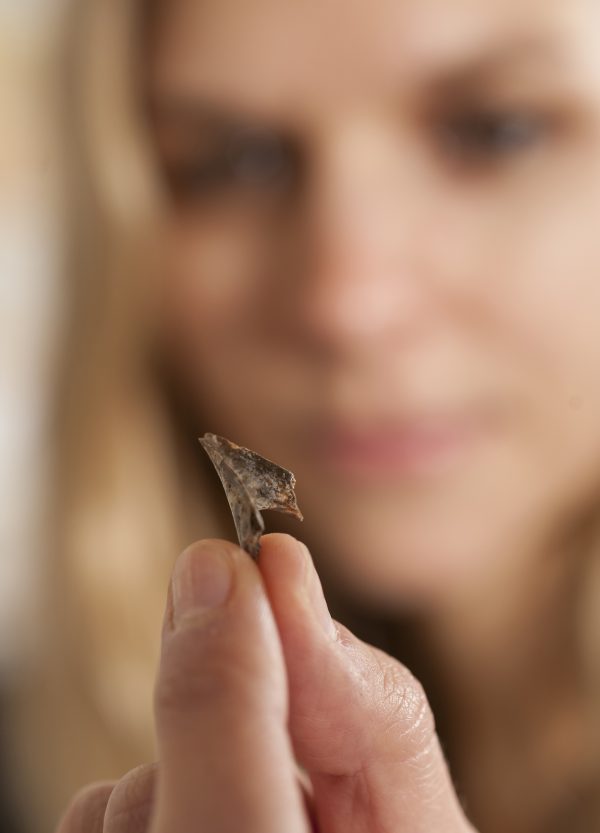A new study demonstrates extinction’s ripple effect through the animal kingdom, including how the demise of large mammals 20,000 years ago led to the disappearance of one species of cowbird.
The study shows the trickle-down effect the loss of large mammals has on other species, and researchers say it is a lesson from the past that should be remembered when making conservation, game and land-use decisions today.

Florida Museum photo by Kristen Grace
“There’s nothing worse for a terrestrial ecosystem than the loss of large mammals – and the loss of apex predators like sharks, tuna and other large fish will have the same negative impact on the oceans,” said study co-author David Steadman, ornithology curator at the Florida Museum of Natural History on the UF campus. “We’re seeing it with the loss of lions and elephants in parts of Africa, as well as in Florida with the decline of panthers. There’s no question these losses will have a negative domino effect on our ecosystems.”
The fossil study of eight songbird species from northern Mexico by Florida Museum ornithologists is currently available online and will appear in Tuesday’s print edition of the journal Palaeogeography, Palaeoclimatology, Palaeocology.
An extinct cowbird, Pandanaris convexa, is the most common bird found at the fossil site called Térapa, in Sonora, Mexico, about 150 miles south of Arizona. This is the first time fossils of the large bird, a member of the blackbird family, have been found in Mexico.
Finding the extinct cowbird at the fossil site was unpredictable and unexpected, according to Jim Mead, chair of the department of geosciences at East Tennessee State University, who has collected a variety of fossils at the site, including the birds used in the study. Mead described the findings at Térapa as “bizarre and exciting.”
“The tropical environment is unusual because the site is so far from the coast,” Mead said. “The fossil record also provides evidence animals migrated from north to south and, unexpectedly, from south to north.”
The cowbird has previously only been found at the Rancho La Brea fossil site in California and a site in Reddick, between Gainesville and Ocala in North Central Florida. The study expands the bird’s known range and creates new questions about whether it may have lived across the southern U.S.
“The extinct cowbird needed grasslands and these big mammals to survive,” said lead author Jessica Oswald, a National Science Foundation predoctoral fellow at the Florida Museum. “Those two things play into each other because mega mammals maintain grasslands. They keep big trees from coming in and colonizing the areas because they graze, stomp and trample little saplings.”
Like modern cowbirds, this species probably fed on seeds and insects large mammals exposed, Oswald said. The mammals included extinct species of ground sloth, mammoth, horse, tapir, camel and bison.
About 20,000 years ago, most of these large mammals went extinct, which lead to the extinction of scavengers like condors and vultures, as well as cowbirds, Steadman said. Extinctions, especially mass extinctions, can cause radical species loss and changes in species distribution.
“Big species can’t exist in a vacuum, nor can smaller species,” Steadman said. “When one piece of the puzzle goes extinct, there is no good way of predicting what sort of trickle-down effect, what kind of cascade effect that will have.”
The study also confirms the area was once marshy grassland, possibly surrounded by a savanna near a river. Fossils of plants, reptiles and mammals of all sizes, and 31 species of birds other than songbirds have been recovered from the Térapa site over the past 10 years. Most of these species are found today in grasslands or wetlands, Steadman said.
Steadman and Oswald used the Florida Museum’s more than 24,000 skeletal specimens of birds to identify the Mexican fossils.
Songbirds make up more than 50 percent of the world’s living bird species, but the fossil record is poorly developed, especially in Central and South America. Oswald said this study helps build the fossil record of songbirds in Mexico.
Finding bird fossils, as well as bones of other small animals, is a time-consuming and labor-intensive process. Sediment is placed in a fine mesh sieve and water is used to remove dirt and debris from the bones.
Learn more about the Vertebrate Paleontology Collection at the Florida Museum.
Learn more about the Ornithology Collection at the Florida Museum.